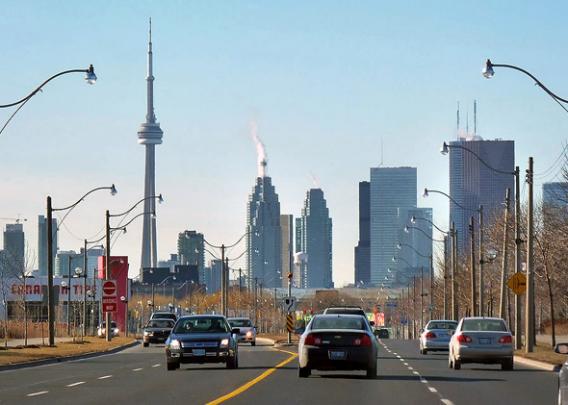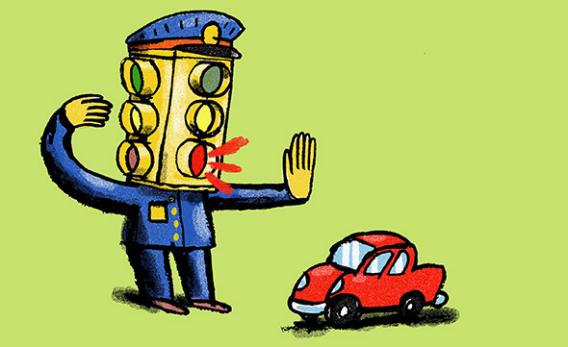Two months ago, Google paid an estimated $1 billion for a company it said will revolutionize the way people get around. The company Google bought doesn’t make electric cars. It doesn’t make solar-powered airplanes. It doesn’t make any vehicle at all.
Waze, the Israeli startup for which Google paid an Instagram-size bounty, is an app that aims to help drivers avoid traffic jams. Drivers use the software to report road congestion to one another—and thus, they hope, reduce their commute times, fuel consumption, and greenhouse-gas emissions, all without ever changing the vehicles they drive. That Google paid an estimated 10 figures for Waze is the latest sign of a subtle but potentially significant shift in the future of transportation: a change not in what cars have under the hood, but in how they behave on the road.
Amid all the turbocharged talk of Priuses, Leafs, and Teslas—cars that curb fuel consumption by replacing your grandfather’s internal-combustion engine with a hybrid or fully electric motor—a bevy of technologies aim to reduce cars’ environmental impact by choreographing how, when, and where they move around. Less sexy than a new engine but often as technologically complex, the alternatives range from car-sharing programs to smart-traffic-light networks to GPS-enabled systems that reward drivers for commuting before or after the height of rush hour. Many of these ideas are attracting real money, and their environmental benefit could be large.
In Toronto, a university team has rolled out a software system that enables traffic lights to learn how cars and trucks flow under them—and then adjust their patterns of reds and greens to move that traffic more smoothly. The software, which uses artificial intelligence techniques, is installed at 59 intersections in downtown Toronto. The team’s computer modeling says this system of “smart self-learning traffic lights” reduces travel times by 25 percent and lowers carbon-dioxide emissions by 30 percent, according to a report issued this spring by the University of Toronto’s Baher Abdulhai, who is one of the system’s designers.
A slick piece of traffic-light software doesn’t get the juices flowing as much as, say, a battery-powered car that can rocket from zero to 60 in fewer than four seconds and never needs to fill up at a gas station. (That car would be the Tesla Roadster.) But such ho-hum advances may matter more. The United States has approximately 100,000 plug-in electric vehicles on the road, according to Plug In America, an electric-vehicle advocacy group. Though that’s a big jump from a few years ago, it still constitutes just 0.04 percent of the roughly 250 million cars of all types on American roads. And given that not quite 16 million new cars are sold in the United States annually, turning over today’s auto fleet will take many years. That means techniques that make the existing mass of cars move around more efficiently could have a much bigger near-term effect than radically environmentally friendlier ways to spin a car’s wheels.
All across the gargantuan global energy system, the realization is settling in that harnessing information technology could save massive amounts of wasted power. That’s the idea behind the “smart grid,” an ill-defined and sometimes-hyped concept of a more-efficient electricity-transmission system. In contrast to today’s decades-old (and generally dumb) power grid, in which power plants typically are oversized so they can handle peak loads, a smarter grid would exploit new hardware and software to match power supply more nimbly and efficiently with fluctuating power demand.
The automotive analog of the smart grid is what some have dubbed the smart road. Companies from Google to major auto makers are testing cars that either are fully driverless or use technology to minimize a driver’s role in controlling the vehicle. One ostensible benefit of Big Brother sitting at the wheel is that he’d probably operate the car in a way that gets better gas mileage than you would. In Europe, a consortium of institutes and companies that includes Volvo is developing what it calls “road trains.” The concept, funded by the European Commission, is part NASCAR and part George Jetson.

Photo courtesy of Diego Silvestre/Wikimedia Commons
It works like this: A motorist—call him George—uses software embedded in his car to hitch his car to a motorcade led by a truck that’s operated by a professional driver. Once George’s car is part of the virtual road train, it enters what the program’s organizers call “semi-autonomous” mode, in which George relinquishes much of the control of his car to the pro at the front of the train. George then sits back and, according to the organizers, can “do other things that would normally be prohibited for reasons of safety; for example, operating a phone, reading a book, or watching a movie.” (The organizers don’t suggest George pop open a beer.) The experimental road trains have been tested on the highway in Europe at speeds of about 55 miles per hour. The environmental benefit: The cars in the road trains are separated by only about 20 feet, reducing drag and improving fuel economy.
Other, less technologically radical smart-road trappings have begun rolling out on a bit larger scale. More and more cities around the world have car-sharing programs, which use wireless technology to enable someone who has signed up to find an available car using a computer or smartphone and unlock it using a program’s membership card. Typically a user pays per-minute or per-hour for the car. When she’s done with it, she parks it near her destination, either in one of the car-sharing program’s designated spots or in a regular on-street parking space. The details vary according to the program. Because at least some members do away with owning a car, each shared car reduces the number of total cars on the road.
Fewer drivers tooling around city streets in their cars in search of parking spaces could have a sizable effect on the roads. An analysis of several studies conducted over many decades suggests that a whopping 30 percent of traffic in large cities is caused by drivers looking for parking spots, according to a 2006 report by Donald Shoup, a UCLA urban-planning professor, who with his students conducted his own deep dive into traffic in Los Angeles’ Westwood Village. More traffic, of course, means more fuel consumed and more greenhouse gas emitted.
In Silicon Valley, America’s petri dish of technological and environmental experimentation, Stanford University has launched a program to try to persuade university workers to commute to and from campus at times other than the worst of the morning and evening rush hours. The program combines modern communications technology with an old-school incentive: cash.
Workers who sign up for the program get an electronic tag that they affix to the inside of their car’s windshield. If scanners mounted at various university entrances detect the cars coming and going at times other than rush hour, the drivers get credits toward a game that pays out cash prizes of up to $50. The program, funded in part by a $3 million grant from the U.S. Department of Transportation, is the brainchild of Balaji Prabhakar, a Stanford professor who designed a similar program for a company in India. Prabhakar says data so far suggests the program is minimizing traffic into and out of Stanford at peak rush hour. He doesn’t have data on whether it’s doing anything about the time drivers are stuck, burning fuel, in traffic jams on the wider road network. (Full disclosure: I work at Stanford, though I’m not part of the program. I bike to work, and only recently was the program expanded to reward Stanford workers who ditch their car commutes altogether and bike. Note to self.)
Silicon Valley also is home to Google, the new owner of Waze, the traffic-avoidance app, which says it has tens of millions of users feeding it road-condition information. Last week, Google announced that Waze traffic information will be integrated into Google’s Google Maps app.
Waze and other apps like it won’t do much for your green cred. Unlike an electric car in your driveway, they’re not likely to turn your neighbors’ heads. But they may do more today than a low-volume electric car to reduce the amount of gasoline that the auto fleet burns. Cool technology comes in many varieties. For the foreseeable future, the kind that’s largely invisible may matter more than the kind that’s shiny and red.
